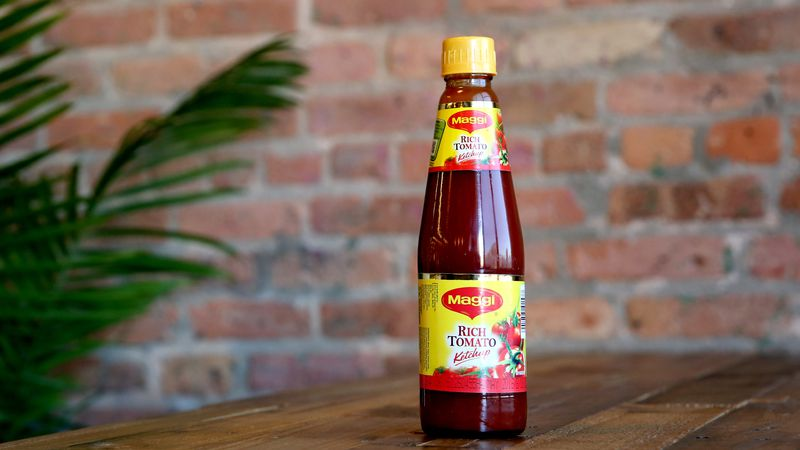Ketchup Sandwich? Only If It's From India
We may receive a commission on purchases made from links.
Twenty-three million people ride India's train system every day, sardine packing themselves into tiny train cars—and sometimes hanging off the sides—to traverse the subcontinent in the antithesis of style and comfort. Often there's one, and only one, snack offering on these trains: ketchup sandwiches. What is a ketchup sandwich? Surely it's something more nuanced and complex than its humble name suggests? Nope. It's ketchup on white bread, full stop. And yes, it sounds terrible. Indian ketchup, however, changes the equation.
The first time I ever had one was on the five-hour train ride from Delhi to Agra. A chaiwalla tossed a ball of foil my way after he finished pouring me a cup of hot chai. Starving, I unwrapped the package, beheld the flat, sad-looking specimen inside (like an Uncrustable had gone through the spin cycle), and hesitantly tasted it, only to realize—wait a minute—that it totally rocked my world. It had sweetness and tang, a touch of spice, and was addictive upon first bite.
That's because Maggi, the preferred ketchup of India, isn't like its American equivalent Heinz. Take the best qualities of ketchup—salt, umami, the equilibrium of flavors—then enhance them tenfold, and you have Maggi. With Maggi ketchup, there's more seasoning and more punch, like a Heinz that's been spiked with a mixture of gochujang and barbecue sauce. Indian cuisine is known for its intensity of flavor, and that extends even to the humblest condiments.
In fact, condiments are king in India. While many Western cuisines preach the gospel of simplicity and highlighting the natural flavor of the ingredients, Indians take the opposite approach: season, season again, and what the hell, season some more. Only in Indian cuisine is there an entire category of food—chaat—where each dish consists of 95 percent condiments. Among them, Maggi ketchup enjoys a special place in my homeland.
Maggi ketchup hails from the Swiss company, Maggi, which was acquired by Nestlé in 1947—the year of India's independence from British colonialism. In the years that followed, the company set up a factory in India and entered its products, which included both sauces and instant noodles, into the Indian market, beginning in the early '80s. They were an immediate hit, as they combined the convenience of packaged foods with categories of dishes and flavors that were familiar to and beloved by Indians. It was one of the first outside food companies that, by virtue of actually setting up shop in India, really understood the country's culture and culinary sensibilities. Along the way, Maggi earned the immense brand loyalty that it retains today, whether it's for its Hot & Sweet Tomato Chilli Sauce or Instant 2-Minute Noodles (India's best-selling cheap meal that practically every native—regardless of class, region, or age, knows how to make—as well known there as Kraft Mac & Cheese is here).
For Indians, Maggi ketchup delivers all our required sensory components—hot, sweet, tangy, and tart—that the most popular kinds of chutneys and spices contain in bits and pieces, all in a single, convenient bottle. There's also a more essential reason for its popularity: the easy availability of the tomato in India. When the tomato was introduced by the Portuguese during colonization, Indians realized that the country's climate (hot and sunny) was ideal for growing the fruit. North Indians also found that the tomato was the ideal ingredient to mix into their sabzis (vegetable stews), as it created a sauce that would nicely cling to their beloved roti bread. Now the tomato is one of the most inexpensive and widely available fruits in India, a progression that has surely paved the way for the country's ketchup obsession. And sure enough, you'll find Maggi ketchup as a staple at restaurants, in grocery stores, and on dinner tables. Even when you go to McDonald's and order a McAloo Tikki burger (a wonderfully spicy potato patty creation), you will most assuredly be served Maggi ketchup on the side.
The ingredient lists on bottles of Heinz and Maggi ketchup read relatively similarly, both containing the usual suspects like tomato paste, sugar, salt, and onion powder. But Maggi ketchup also contains garlic powder and a blend of familiar Indian spices that make it different. Still, what elevates Maggi above all other ketchups, in my mind, is its true versatility. Sure, you can put regular ketchup on lots of dishes—french fries, grilled cheese sandwiches, eggs, steak (though I've never really understood that one). But you can put Maggi ketchup on all these things and more. Basically, if a dish is savory and/or deep-fried, there is a strong chance it will taste fantastic dunked in Indian ketchup.
I must admit that, when I was little, I got mocked by non-Indians for putting ketchup on everything (though granted, maybe they were laughing at me hoarding ketchup packets in my Mighty Ducks fanny pack). But of course, we mock what we don't understand, and perhaps what they didn't comprehend was the limitations of the American ketchup they were accustomed to. If only they could have tried something as simple as an Indian ketchup sandwich, they'd get it.
